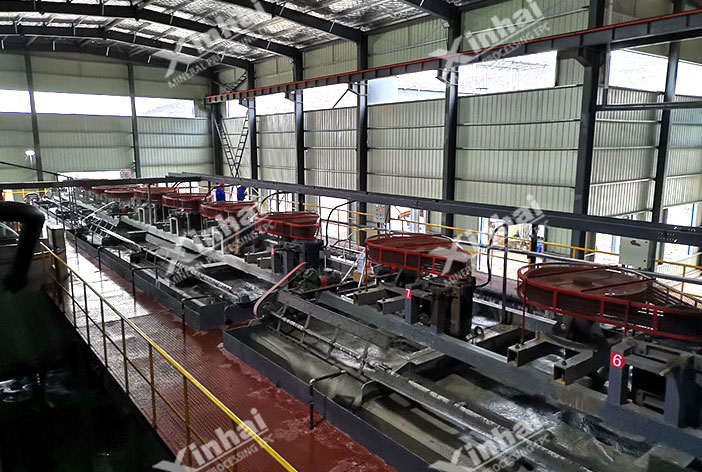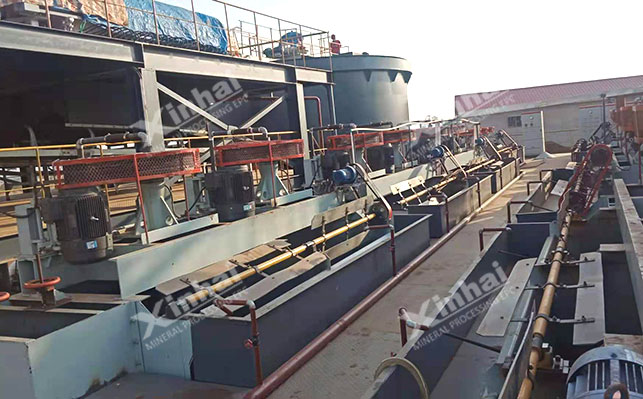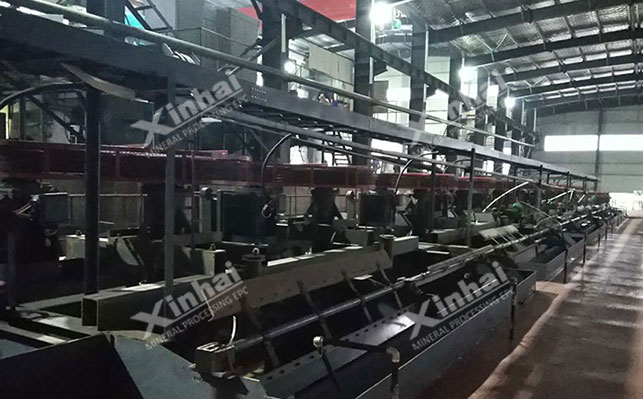
Most scheelites are sandstone type and composite type (vein disseminated type-greytzite skarn composite type), which are often associated or symbiotic with a variety of non-ferrous metal minerals such as molybdenum and bismuth. The useful minerals are embedded in fine grain sizes and are mostly in the form of Disseminated and embedded in the ore. Generally, scheelite has a fine crystal size and good floatability, so flotation is often used to recover scheelite.
Roughing of scheelite, beneficiation of scheelite, heated flotation of scheelite, and room temperature flotation of scheelite.

15311826613
Click to add WeChatThe scheelite flotation process is mainly divided into two parts: roughing and selection. Among them, roughing is to eliminate gangue minerals to the greatest extent to improve roughing. enrichment ratio. The beneficiation is the key to the entire scheelite flotation, with the purpose of obtaining qualified tungsten concentrate.

The commonly used method for roughing scheelite is the lime method, which uses Ca The adsorption of 2+ on the surface of the gangue mineral changes the potential of the surface of the gangue mineral. Subsequently, sodium carbonate is added to precipitate Ca on the surface of the gangue mineral. Ca is also adsorbed on the surface of scheelite, but its surface charge remains unchanged. It is negatively charged and does not produce CaCOs precipitation. Therefore, adding inhibitors such as water glass only inhibits the gangue minerals and has no effect on scheelite, thereby achieving the separation of tungsten ore and gangue minerals.
The key to scheelite beneficiation is to separate the calcium-containing gangue minerals from the scheelite. Commonly used processes are normal temperature method and heating method.
The normal temperature flotation method of scheelite selection
mainly uses the alkaline medium-fatty acid method, which is often used in scheelite roughing. Sodium carbonate-water glass is used as a regulator and inhibitor combination, followed by sodium hydroxide-water glass and sodium carbonate-sodium hydroxide-water glass, etc. The water glass in the above combination is used alone in many cases, and is sometimes used in combination with multivalent metal ions to enhance the inhibitory effect. The normal temperature method pays more attention to the roughing operation, emphasizing the synergistic effect of sodium carbonate and water glass. By controlling the pH value of the slurry, the HSiO3- ions in the slurry are kept in a concentration range that is conducive to oxidation inhibition, and is equipped with scheelite collectors. Achieve a higher roughing ratio. The coarse concentrate is diluted and concentrated after strong stirring for a long time (>30 min) under the condition of adding a large amount of water glass, and the beneficiation cost is relatively low.

The normal temperature method is not very adaptable to ores and is suitable for selecting scheelite-quartz ores. However, its adaptability to other types of scheelite is not as good as the heated flotation method. Flotation white The grade of tungsten concentrate is generally 55%~60% and contains high impurities. Usually, more than 65% of the tungsten concentrate can be recovered by adding hydrochloric acid leaching method.
Sceeel tungsten selected heated flotation method
At present, there are two main types of scheelite heated flotation processes. One is for scheelite. A large amount of water glass is added to the coarse concentrate, and after heating and stirring at a high concentration, the difference in desorption speed of the collector film adsorbed on the surface of the minerals is used to improve the selectivity of inhibition, and then it is diluted and selected. Under this condition, the collector adsorbed on the surface of positively charged minerals such as calcite is fully desorbed due to the strong competitive adsorption of high-concentration remover and thus causes an inhibitory effect, while the scheelite with negatively charged surface is affected by the remover. The effect is small, and the chemical adsorption with the collector can still be maintained, so it can still maintain good floatability, thereby achieving the purpose of separating scheelite and gangue. This method requires multiple dilutions and decontamination before carrying out scheelite flotation. It is suitable for scheelite coarse concentrates with high grade tungsten concentrate and simple mineral composition. It is not suitable for scheelite coarse concentrates with low tungsten grade, calcium-containing gangue and sulfide ores. Coarse concentrate with high content.

The second is to add a small amount of collector before heating, so that the tungsten minerals can pre-adsorb the collector, and make use of the difference in the ability of tungsten minerals and gangue minerals to adsorb collectors and the use of large amounts of collectors. The speed of resolving chemicals under the action of water glass and strong alkali is different, achieving selective inhibition of calcium-containing gangue minerals. According to the mineralogical characteristics of scheelite coarse concentrate, a small amount of hydroxide is selectively added while adding a large amount of water glass. Sodium and sodium sulfide strengthen the selective removal and inhibition of gangue minerals and sulfides. After heating or stirring at room temperature, the slurry is directly flotated without dilution, desliming, or drug removal, which greatly simplifies the selection operation, avoids the loss of tungsten metal during multiple dilution processes, and makes the calcium-containing gangue minerals and sulfide have been in a strongly inhibited state under high alkalinity, while tungsten minerals have been in a good activated state under high alkalinity, thus further improving the tungsten concentrate grade and recovery rate.
Heated flotation has strong adaptability to ores and stable separation indicators, and is suitable for processing scheelite-calcite-fluorite type ores. After coarse separation to obtain low-grade coarse concentrate, higher-grade scheelite concentrate is obtained using the thick slurry high-temperature method. The essence of the heating method mainly refers to the concentration of roughly selected concentrates. The concentration of the concentrated slurry is between 60% and 70%. Then a large amount of water glass is added to it, stirred at high temperature, and finally the slurry is diluted. , and then flotation at room temperature.